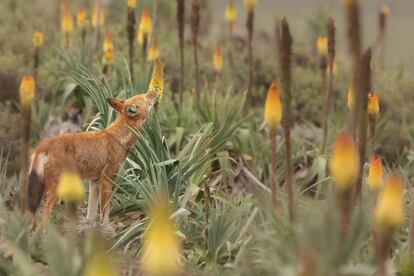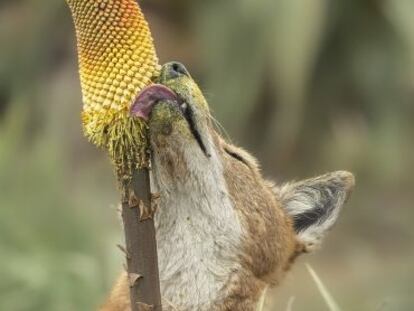The strange Ethiopian nectar-eating wolf: A predator that may also act as a pollinator
Researchers at Oxford University have managed to document the unusual feeding behavior, unique among carnivorous animals, of this endangered African canid

Ethiopian wolves love to roam the flower fields of the Bale Mountains in the south of this African country. Some of them can do so for up to an hour and a half, excited by the bright orange spikes of a plant typical of that area. Attracted by its sweet nectar, they eagerly lick the ripest flowers, while their muzzles become covered in the sticky yellow pollen that tastes like honey. For the first time this behavior, so peculiar for a large predator, has been documented thanks to a study carried out by a team of scientists led by Sandra Lai, a biologist at the University of Oxford (United Kingdom).
The Ethiopian highlands, home to this distinct species of wolf — Canis simensis — offer a tundra-like landscape: relatively desert-like, treeless, and with an essentially dry climate. There, between late May and early June 2023, researchers followed six individuals from three packs that are monitored regularly by the Ethiopian Wolf Conservation Program. For four consecutive days, following in an off-road vehicle, researchers observed the foraging mammals from about 25 meters away.
Although the diet of Ethiopian wolves is mainly composed of rodents such as the African mole rat, scientists also recorded with videos and photographs their fondness for licking flowers, which may represent a rare case of interaction between plant and pollinator.
The flowers of Kniphofia foliosa, a member of the torch lily group, often attract a variety of animals and insects, especially during the flowering season between June and November. “The role of Ethiopian wolves as functional pollinators would depend on their actual ability to transfer pollen from one flower to another, resulting in fruiting, which has not yet been assessed,” says Lai, adding: “This year we have seen adult wolves leading younger ones into flower fields, which could indicate cultural transmission.” The behavior was known to scientists tracking the endangered animal but had never been documented.
The authors acknowledge that it remains to be determined what role pollen plays in the diet of wolves and whether these animals are functional pollinators. Agroecologist Jesús Quintano explains that a plant is pollinated by a multitude of species: some are the main ones and others are only complementary and can help optimize this process. “They will have to study to what extent the pollination carried out by the wolf is important. I fear that in this case it will be a minor role,” says this scientific communicator, who was not part of the study.

Insects are the largest group of pollinators in the world, but other cases have also been reported involving some reptiles — for example, the Balearic lizard — birds such as the hummingbird, and even species of small mammals such as squirrels and bats. Quintano indicates that a plant known as Anagyris foetida in Spain’s western region of Extremadura is usually pollinated by the common chiffchaff and warblers, birds that visit its flowers and transfer the pollen. “It was the first case of this type recorded in Europe, in 2005, and it was discovered how these birds use nectar as a food resource,” says Quintano in reference to a phenomenon known in biology as ornithophily.
Wolves also disperse seeds
“Both plants and animals provide us with services that sustain life on Earth,” says Alicia Solana, a researcher at the University of Sains Malaysia and the Scientific Society DIRUS. Pollination by non-flying mammals is known as therophily. The scientist and her team are currently developing a line of research on seed dispersal by the grey wolf (Canis lupus) in the Iberian Peninsula.
Ángel M. Sánchez, an independent researcher at the University of Alcalá and founder of the Wolf Census Volunteer Program, explains that these animals are evolutionarily adapted to eating a wide range of resources. “It is not unusual for wolves to eat juniper berries, blueberries or even grapes at certain times. We have confirmed this by collecting the excrement of these animals,” he says. The analysis, which will be published during the course of 2025, focuses on the habitat of the grey wolf in the Central Iberian System, between the Spanish provinces of Ávila, Madrid, Segovia and Guadalajara.
Regarding the role of wolves as seed dispersers and as possible pollinators, in the case of the Ethiopian wolves, Solana states that these “are less well-known services, but very valuable, especially to raise awareness in society and better understand the wolf and its ecology. It is very important to understand that predators can also play other roles in nature.”
Sign up for our weekly newsletter to get more English-language news coverage from EL PAÍS USA Edition
Tu suscripción se está usando en otro dispositivo
¿Quieres añadir otro usuario a tu suscripción?
Si continúas leyendo en este dispositivo, no se podrá leer en el otro.
FlechaTu suscripción se está usando en otro dispositivo y solo puedes acceder a EL PAÍS desde un dispositivo a la vez.
Si quieres compartir tu cuenta, cambia tu suscripción a la modalidad Premium, así podrás añadir otro usuario. Cada uno accederá con su propia cuenta de email, lo que os permitirá personalizar vuestra experiencia en EL PAÍS.
¿Tienes una suscripción de empresa? Accede aquí para contratar más cuentas.
En el caso de no saber quién está usando tu cuenta, te recomendamos cambiar tu contraseña aquí.
Si decides continuar compartiendo tu cuenta, este mensaje se mostrará en tu dispositivo y en el de la otra persona que está usando tu cuenta de forma indefinida, afectando a tu experiencia de lectura. Puedes consultar aquí los términos y condiciones de la suscripción digital.
More information
Archived In
Últimas noticias
From safe-haven investment to geostrategic weapon: Who owns the most gold and where are the bars kept?
Todd Green, head of the company that created ‘Candy Crush’: ‘Success for us is that players want to play for years’
Prices soar and Venezuela’s economy struggles under Trump’s pressure: ‘People are living day to day’
From Hungary’s Orbán to Chile’s Kast: How Trump helps turbo charge the far right
Most viewed
- Why we lost the habit of sleeping in two segments and how that changed our sense of time
- Charles Dubouloz, mountaineering star, retires at 36 with a farewell tour inspired by Walter Bonatti
- Venezuela faces its most tense Christmas yet
- CBS in crisis after pulling a report on Trump’s deportations to El Salvador (which later leaked online)
- Bukele clan fumes over investigation exposing their new wealth











































